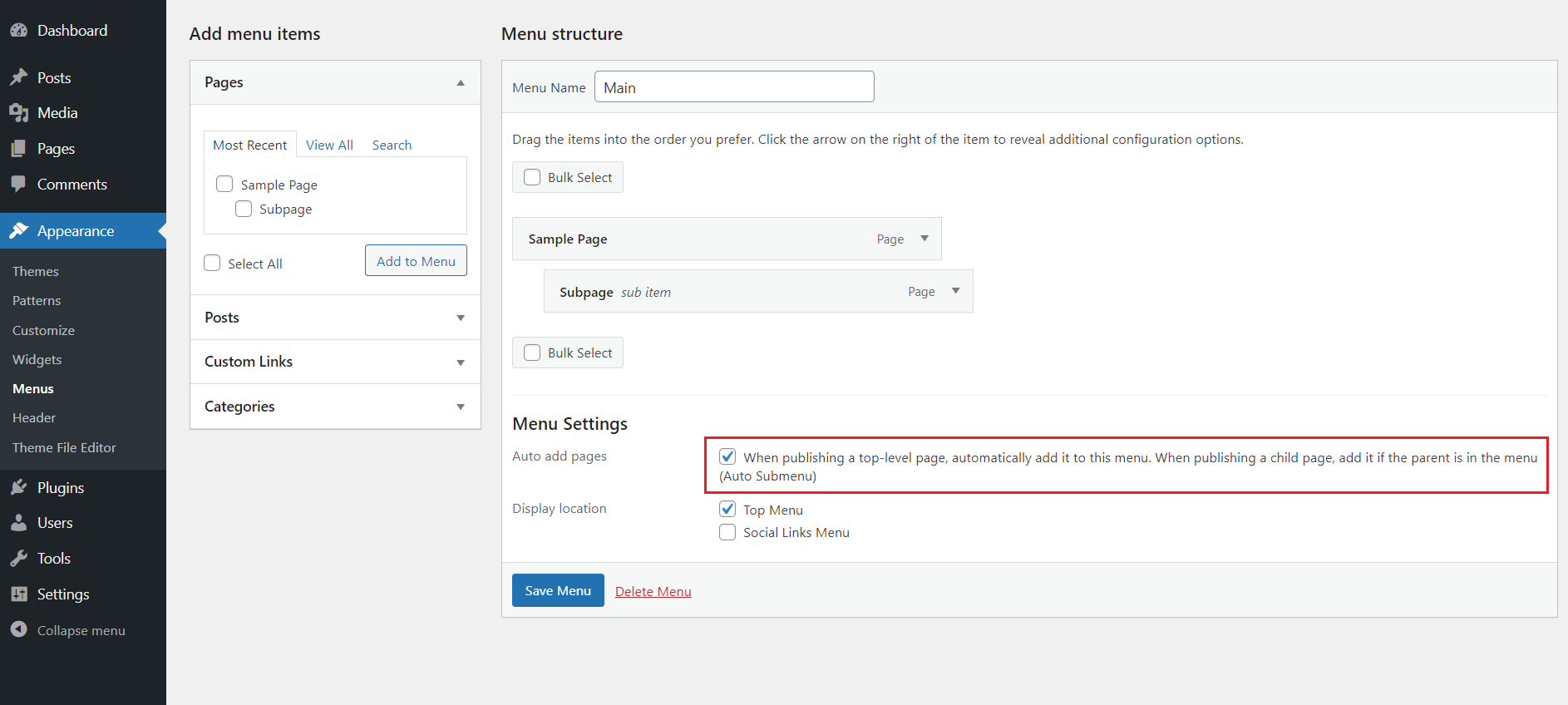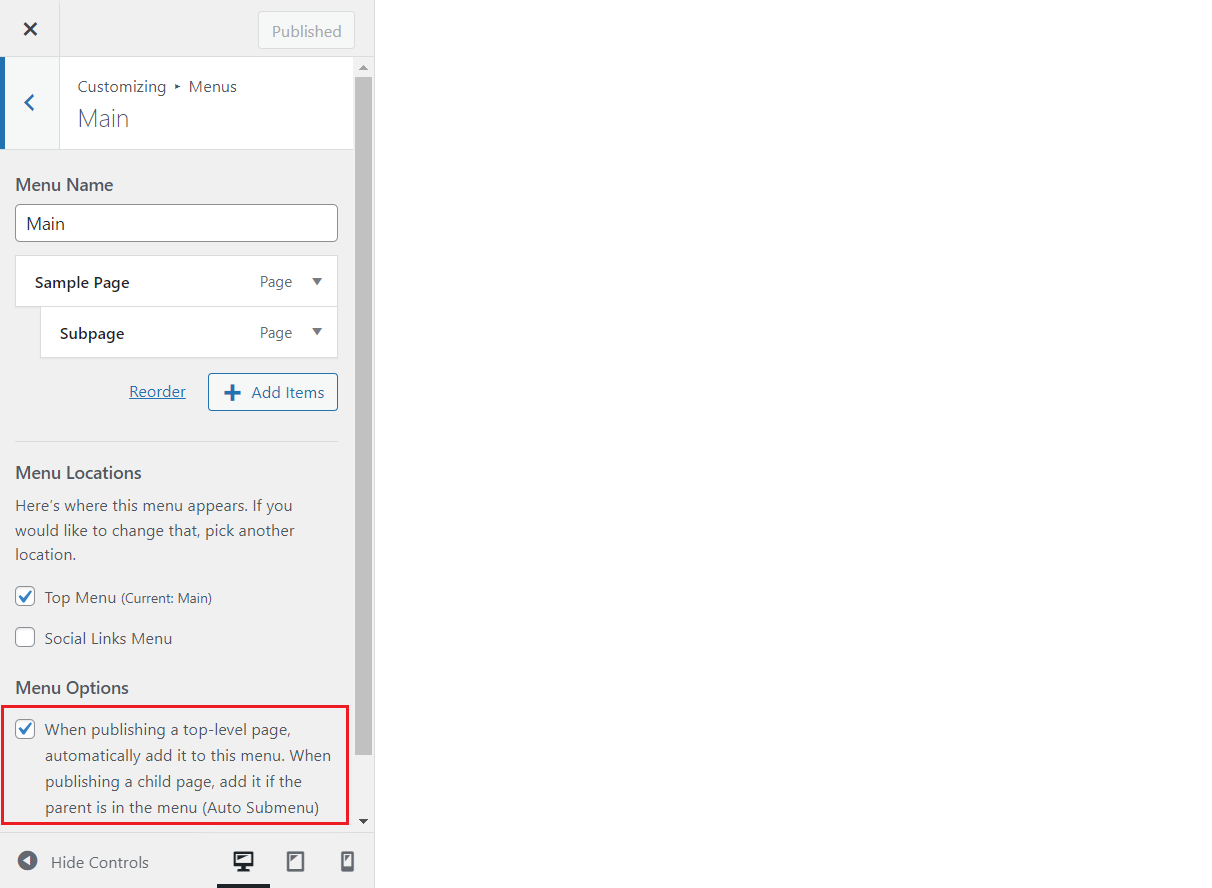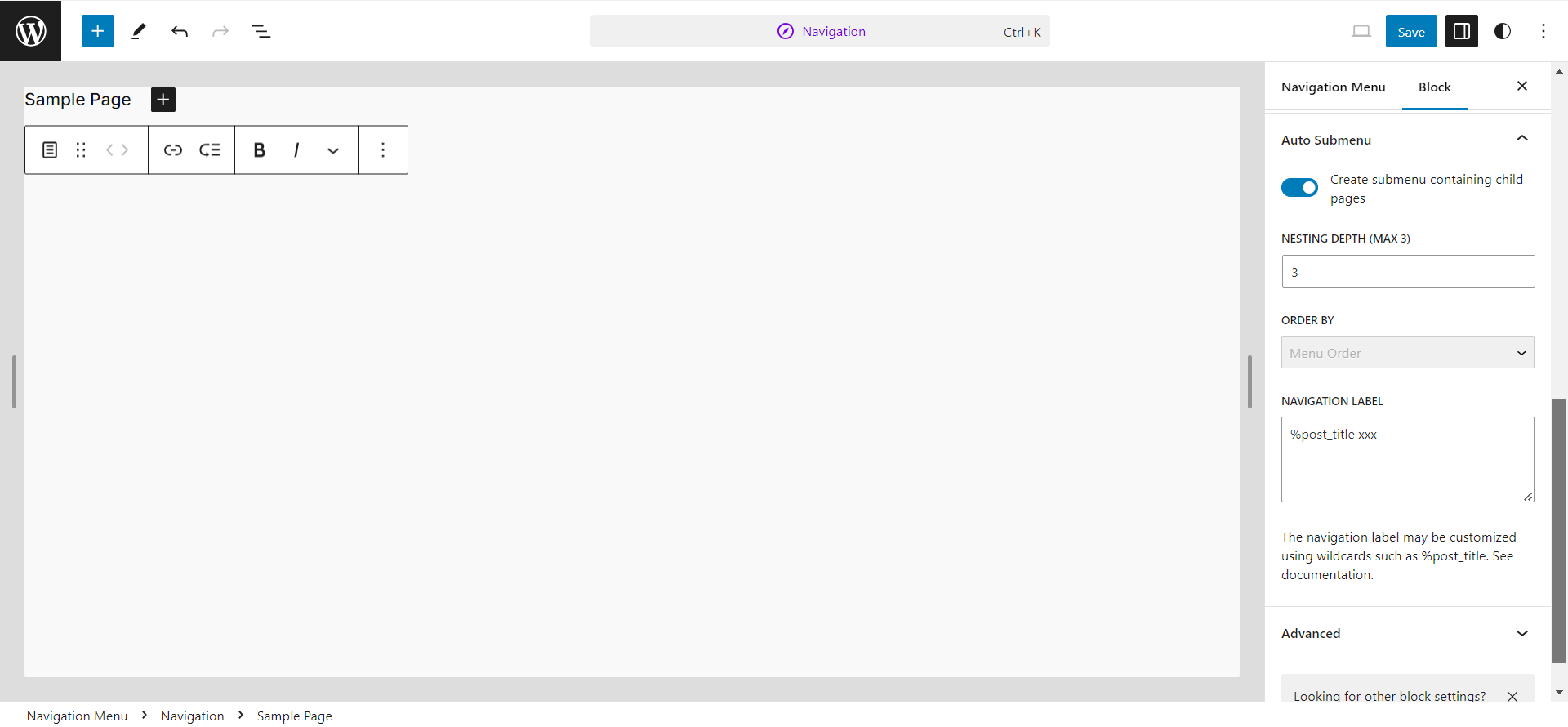Description
The default custom menu in WordPress only allows checking the “Automatically add new top-level pages” (Appearance > Menus) or adding a Navigation block with all pages and all child pages (Appearance > Editor).
With Auto Submenu you get extra functionality to automatically include child pages into the menu.
NEW: ASM now provides support for the Customizer via Appearance > Customize
NEW: ASM now provides support for Full Site Editing with the Gutenberg Block Editor via Appearance > Editor
Using it
Enable the plugin and go to Appearance > Editor.
For each Page in your menu, you now have the following extra configuration options:
- Add child pages as submenu y/n;
- child pages are ordered ascending by Menu Order;
- specify the (maximum) nesting depth of children you want to show (max 3);
- specify the title for the child pages. For this you can use %post_title, %post_author and other wildcards, see ‘Other Notes > Wildcards’. Default value: %post_title
Via Appearance > Menus and Appearance > Customize you also get the following option:
- Check the “Automatically add new top-level and all its child pages to this menu (Auto Submenu)”-checkbox.
- If this option is checked, all top-level pages will automatically be added and will automatically have all child pages added as submenu.
With the Free version you cannot control the nesting depth of the child pages, all subpages are added, regardless the depth of the page tree.
Wildcards
You can control the title of the menu items generated by the plug-in with the following wildcards:
- %post_title
- %post_author
- %post_date for the unformatted post date: 2012-11-10 18:14:23
- %post_date() for a formatted post date with the following default formatting: November 10th, 2012
- %post_date(<your formatting here>) for custom date formatting. Example: %post_date(l jS \of F Y, h:i:s A). See https://codex.www.ads-software.com/Formatting_Date_and_Time for formatting options.
- %post_date_gmt
- %post_date_gmt()
- %post_date_gmt(<your formatting here>)
Screenshots

Go to Appearance > Menu to automatically add top level and all its child pages to the menu when publishing a page. 
Go to Appearance > Customize to automatically add top level and all its child pages to the menu when publishing a page. 
Go to Appearance > Editor to enable/disable and set the options for adding child pages to each top level page in your menu.
Blocks
This plugin provides 1 block.
- ASM Navigation Link Extension
Installation
- Go to plugins in your dashboard and select “Add New”
- Search for “Auto Submenu”
- Install and Activate the plugin
FAQ
-
How do I use it?
-
Here’s a walkthrough:
- Create a page with title “Page 1”
- Save the page
- Create a child page with title “Child Page 1” and parent “Page 1”
- Save the child page
- Go to Appearances > Menus (or via Appearance > Customize or Appearance > Editor, in WordPress 5.4 or higher)
- Add your page named “Page 1”
- Open the menu item and check “Automatically create submenu with child pages”
- Save the menu
If you now look at your website, “Page 1” has a submenu with “Child Page 1” below it. Add additional child page and you will automatically see these additional child pages in the menu.
-
Missing CSS classes
-
The CSS class ‘current-post-ancestor’ is not applied correctly. This is a bug in WordPress that I have reported here: https://core.trac.www.ads-software.com/ticket/32918 This is not something I am able to fix in the plugin, it has to be fixed in WordPress. I’m sorry for the inconvenience.
-
Performance issues
-
The plugin is potentially very expensive, especially when you have a lot of pages and child pages.
The solution would be to cache the menu using transients, as reported here https://www.ads-software.com/support/topic/performance-problem-many-database-queries?replies=11#post-7829450
$my_cached_menu = get_transient( ‘my_cached_menu’);
if( $my_cached_menu === false )
{
$my_cached_menu = wp_nav_menu( … );
set_transient( “my_cached_menu_”, $my_cached_menu, YEAR_IN_SECONDS );
}
echo $my_cached_menu;
-
Can’t see it working in any way
-
Problem: “I can’t see what effect it has had. Nothing has changed (not that I can see) in the Appearance > Menu/Customize/Editor pages. It’s just like before.”
If you are using a recent version of Auto Submenu and an updated version of WordPress, the problem can only occur due to your theme or other plugins conflicting with Auto Submenu. Please disable all themes and plugins except ASM; verify that the ASM fields show; enable other plugins and themes one by one to determine which plugin/theme conflicts with ASM.
Note: A theme must either call wp_nav_menu() or apply_filters( ‘wp_nav_menu_objects’, … ) for ASM to be triggered.
-
Does not work for scheduled pages
-
Automatically adding future dated child pages doesn’t work due to what appears to be a bug in the WordPress core. Future dated top-level pages don’t seem to get added to custom menus either.
Reviews
Contributors & Developers
“Auto Submenu” is open source software. The following people have contributed to this plugin.
ContributorsTranslate “Auto Submenu” into your language.
Interested in development?
Browse the code, check out the SVN repository, or subscribe to the development log by RSS.
Changelog
1.0.3
- Confirmed compatibility with WordPress 6.7
1.0.2
- Confirmed compatibility with WordPress 6.6
1.0.1
Bugfix: Plugin moved page to the bottom of the submenu.
1.0.0
Now provides support editing via the Customizer.
Now provides support for Full Site Editing with the Gutenberg Block Editor.
0.3.1
- Confirmed compatibility with WordPress 6.4
1.0.0
Plugin has been split into a Free and a Premium version. The Free version functionality is unchanged. Premium version has extended functionality.
0.3.0
- Confirmed compatibility with WordPress 6.3
- If the page is moved under a different parent, also move it in the menu.
0.2
- Added support for multiple menus.
0.1
- First release.